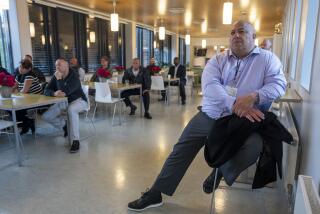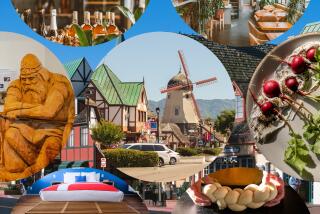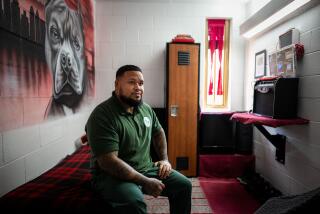VACATION MEMORY : From Copenhagen With Gratitude : Flat on his back in a coronary unit, the author had plenty of time to appreciate Danish medical care.
- Share via
COPENHAGEN — As I lie in my 14th-floor room in Copenhagen, looking out from my comfortable bed through a broad plate-glass window, I can see the golden disk of the sun rising slowly over the bay, surrounded by trailing purplish and yellow clouds. Later in the day, large cruise ships will slip in and out of port along with commercial vessels, and occasionally a high-speed craft comes rushing in from Sweden, just 40 minutes away and visible in the distance across the water.
Am I in the Copenhagen Sheraton or the Hotel d’Angleterre? Not at all. I am in the Coronary Unit of the Danish State Hospital, Rigshospitalet.
Being an avid traveler and convinced that one sees a city best on foot, I must have overdone my walking. Whatever the case, by evening of my third day in Copenhagen, it was clear that something was radically wrong: I was experiencing intense chest pressure. Following the instructions of the tourist brochure, I asked the hotel to dial emergency and within a few minutes, two tall young men arrived and placed me in their ambulance. As we drove to the hospital, one of them gave me oxygen and, leaning close to my ear, said, “You’re in good hands now.” I was more than convinced.
For anyone who has undergone a heart attack, I need not relate the details of checks, blood pressures, examinations and constant vigilance given me for that first day or so. I was placed in the 14th-floor Coronary Unit in a double room with private toilet, and monitored in more ways than I thought possible. It almost seemed like one of those trips on Japan Air Lines where they keep you so occupied that you never have a moment of boredom, except that my entertainment consisted of blood tests, frequent EKGs, blood pressure, an injection of this, a few pills, an injection of that, ice water and a series of visits by nurses and doctors.
The care was overwhelming, the facility impressive. The Rigshospitalet is Denmark’s largest hospital, affiliated with Copenhagen University, and it includes all areas of specialization as well as a research institute. Founded in 1719, and dramatically enlarged just 20 years ago, it has 1,600 beds, 8,000 employees and last year served 57,000 inpatients.
Each day as I began to walk about more, I discovered new indications of a sense of style, like a truly fabulous collection of contemporary prints hanging in the halls and elegant Danish flatware used for meals marked with the hospital’s crest. New elements of thoughtfulness and sociability became apparent, too: a TV set in the hall where one joined other patients to hear the news and watch standard TV fare; a table rolled into the hall in late afternoon and evening stocked with cookies, tea, coffee, hot chocolate and cold drinks, and another table called “The Patients’ Table” with such things as tape, pens and note paper. I was delighted to discover a number of showers available and fresh garments whenever requested.
When I arrived I had, of course, to change many plans. The nurses were most helpful and warmhearted in making phone calls, domestic and international, to cancel flights and reservations and to arrange to have my luggage brought over from my hotel. Going way beyond the call of duty, they allowed me into their office to make a number of long-distance calls to family and friends, since I was traveling alone and had no personal contacts in Denmark.
As one can see, the essentials of first-class medical care were there, along with careful, affectionate nursing, rather than the luxuries of television in each room and private telephones. This helped to bring the patients together into the wider circle of the hospital and to increase my admiration for the Danes, many of whom speak impressive English.
I had assumed, because he was a man of few words, that my roommate, who was to undergo heart surgery in a few days, spoke only a little English. But as I stood at that plate-glass window looking down into the beautiful, original, 18th-Century part of the hospital, which is now a hotel for patients and families, and a bit further out at a vast soccer field marked out for eight or 10 simultaneous games, I asked him a few questions about the sights before us, and discovered his English was extremely fluent. In fact, before going into the hospital, he and his wife had spent three weeks in the United States: Los Angeles, San Francisco and Las Vegas. (He fell in love with San Francisco.)
He pointed out the old customs building off to the northwest, a massive bastion with turrets at either end, and beyond it an island that now houses an atomic power plant. Further north, an immense new football stadium, a few skyscrapers and power plants, here and there an old church tower and way off to the northeast, what my new friend called the “Beverly Hills of Copenhagen.”
How much did I pay for this million-dollar view? Enough to make me go into cardiac arrest? Not at all: It cost me the price of my phone calls. As the tourist brochure had assured me and I later verified, “All foreigners staying temporarily in Denmark are entitled to free treatment in hospitals and casualty wards in the event of sudden illness or aggravation of chronic disease, provided the patient has not come to Denmark with a view to obtaining treatment, or is not strong enough to return to home country.”
How can one forget the warm hospitality and kind generosity of a people so welcoming and friendly? It is difficult to know how to repay all the handsome treatment I have received. One thing I do know: I don’t want too much time to pass before I am again among these big-hearted people, to watch that golden sun rising from the bay outside my window. But next time I hope it will be a hotel window.
More to Read
Sign up for The Wild
We’ll help you find the best places to hike, bike and run, as well as the perfect silent spots for meditation and yoga.
You may occasionally receive promotional content from the Los Angeles Times.






